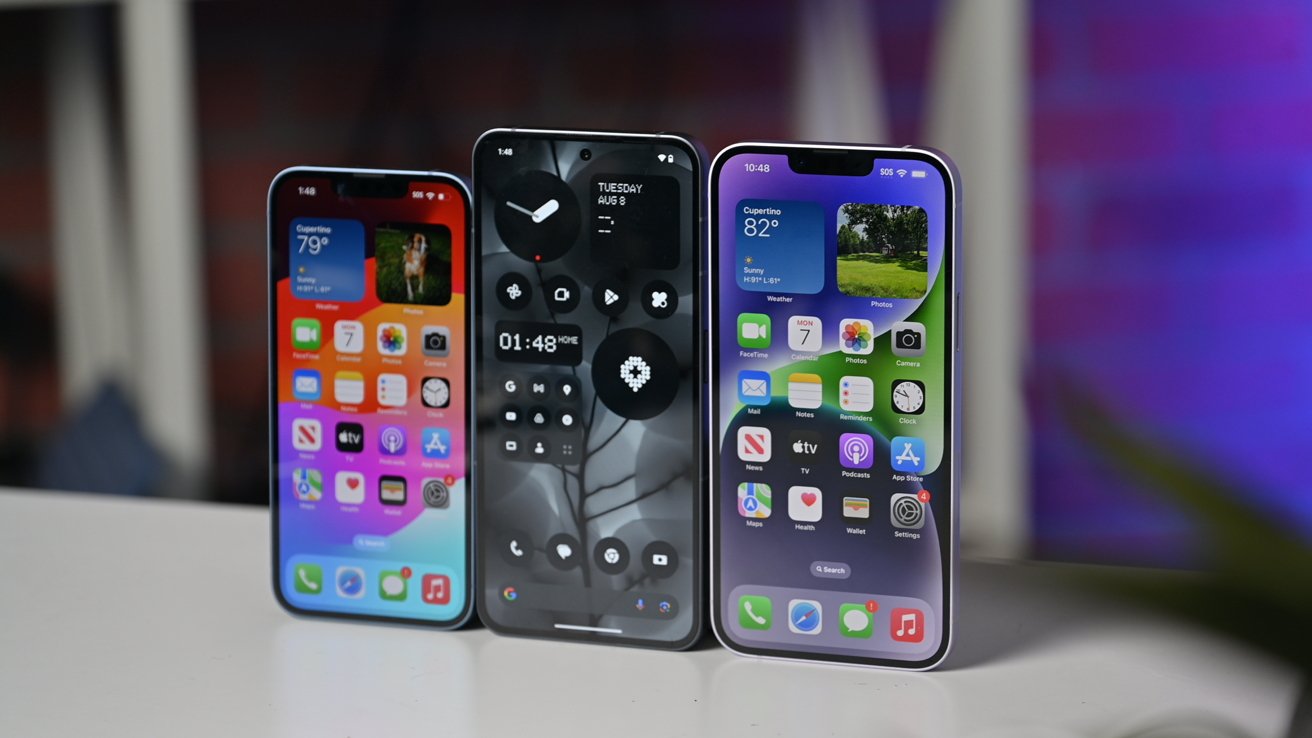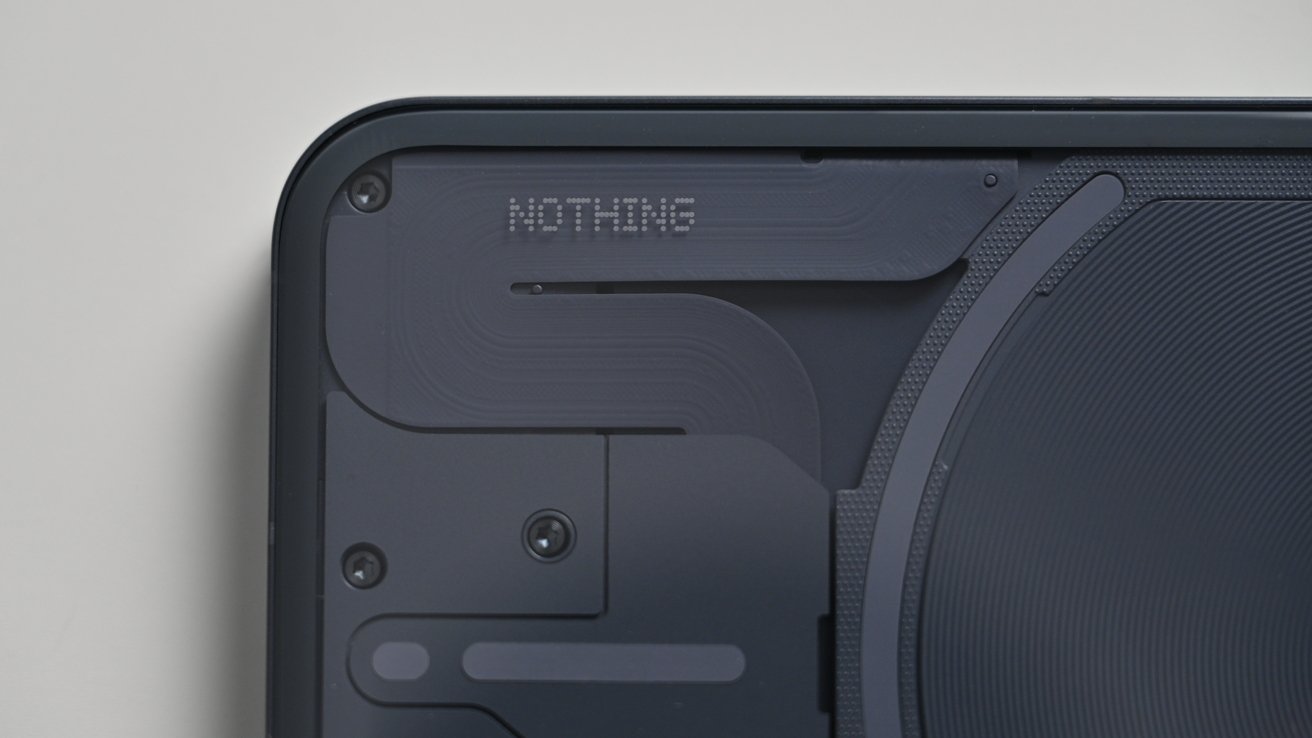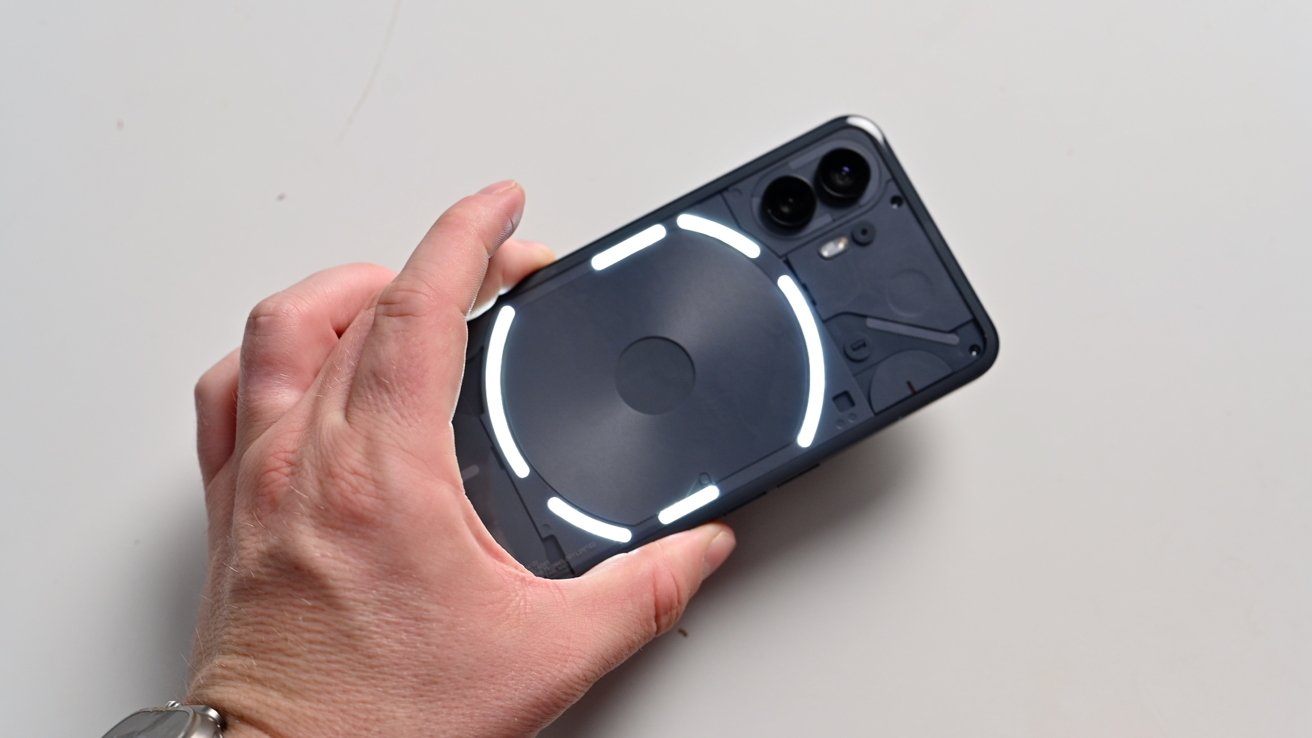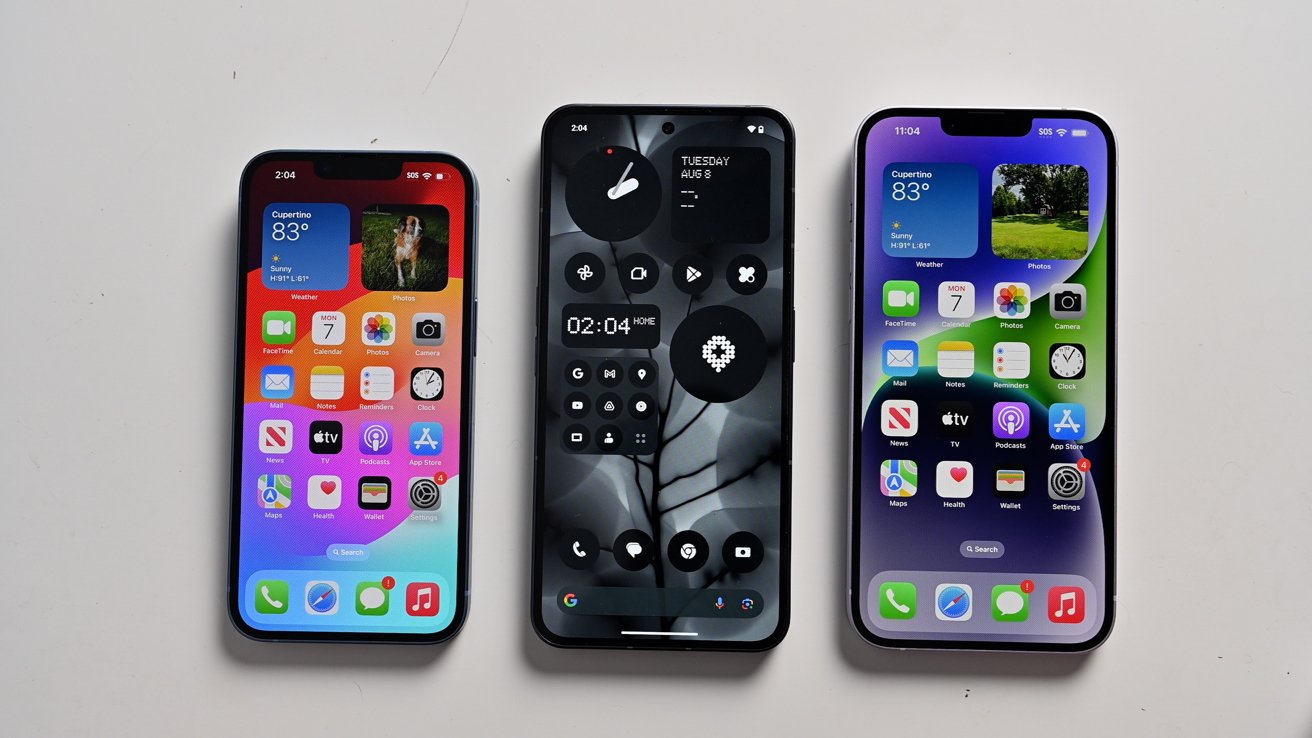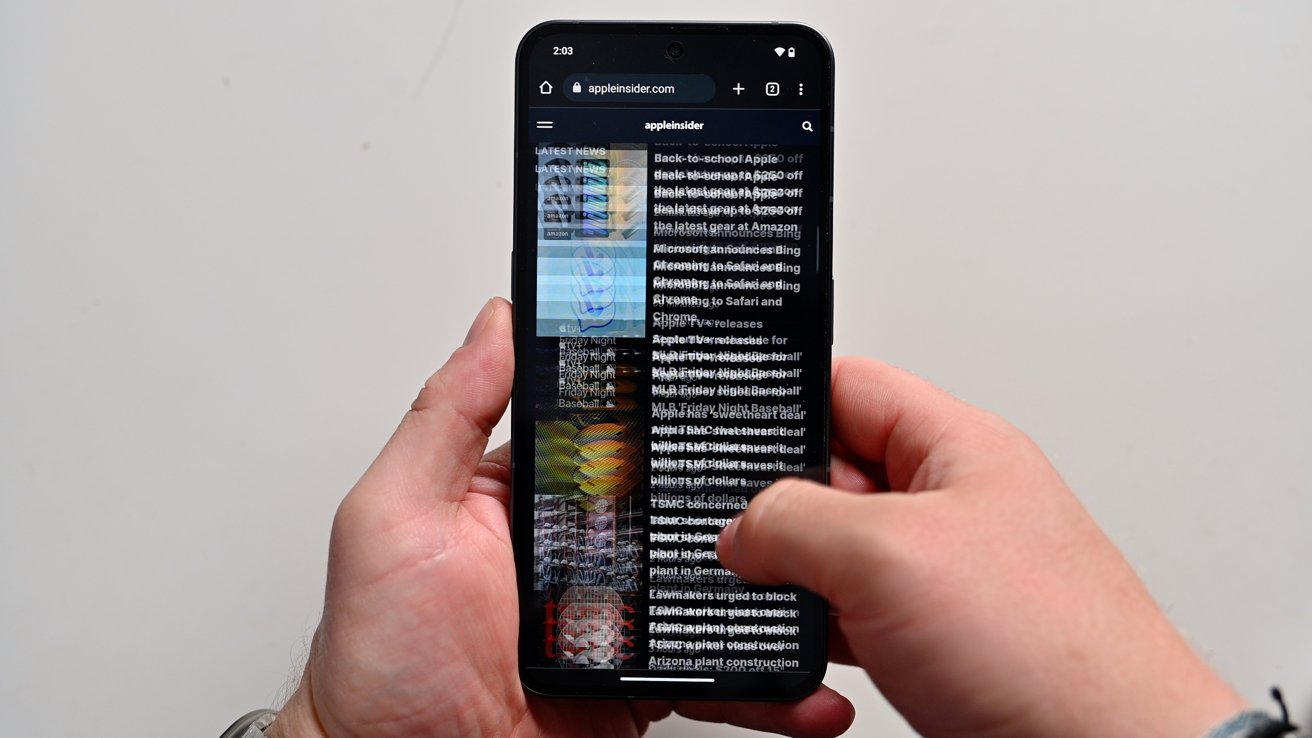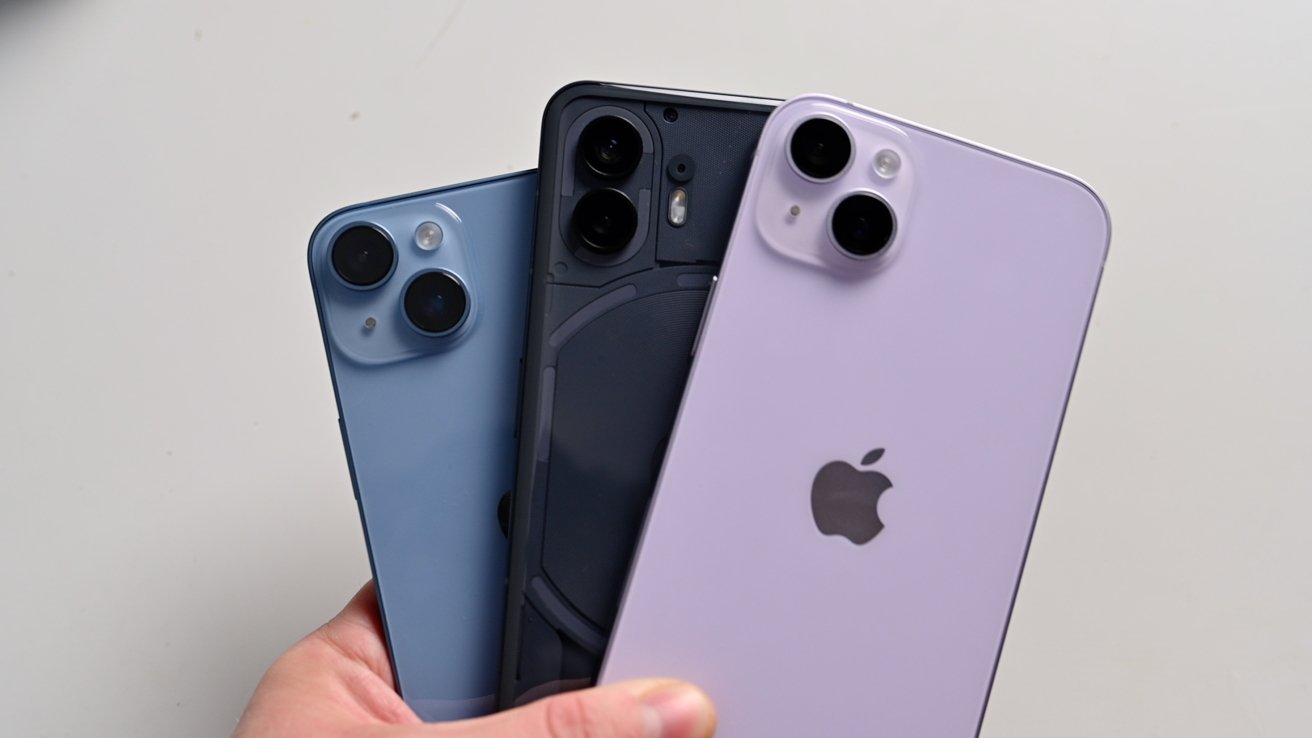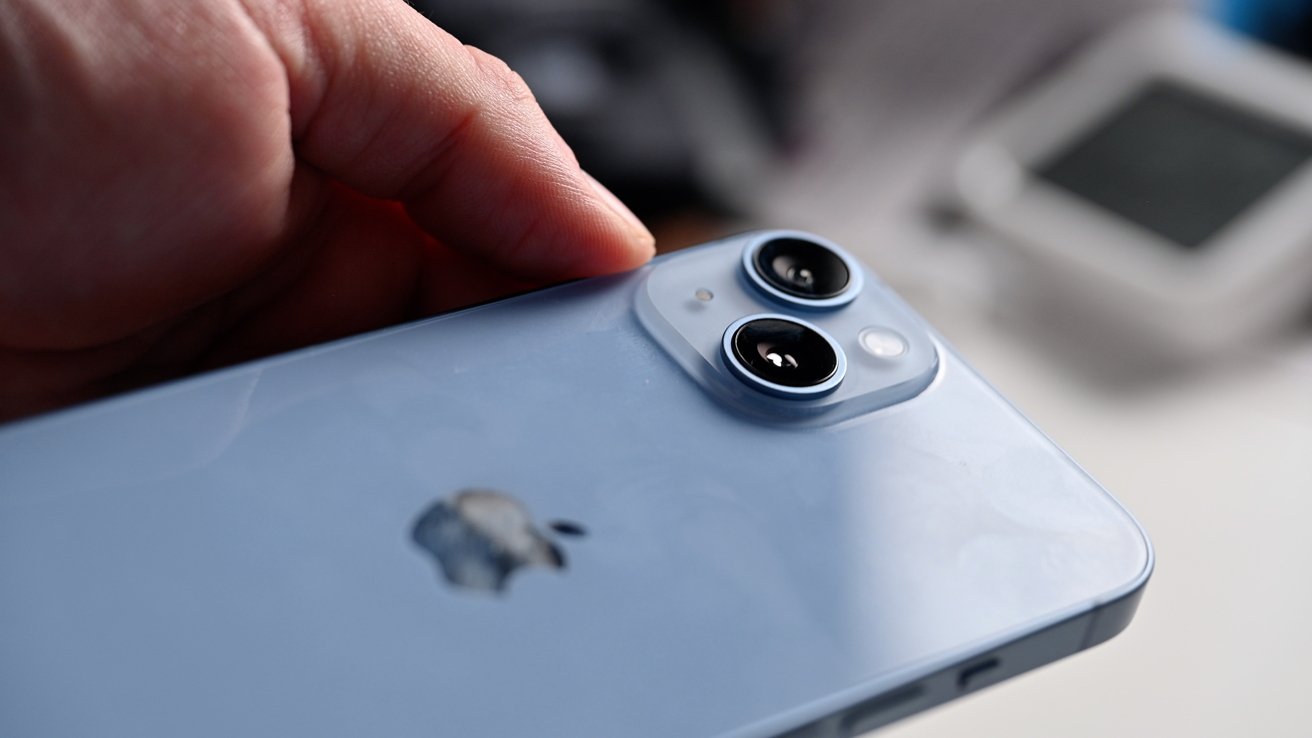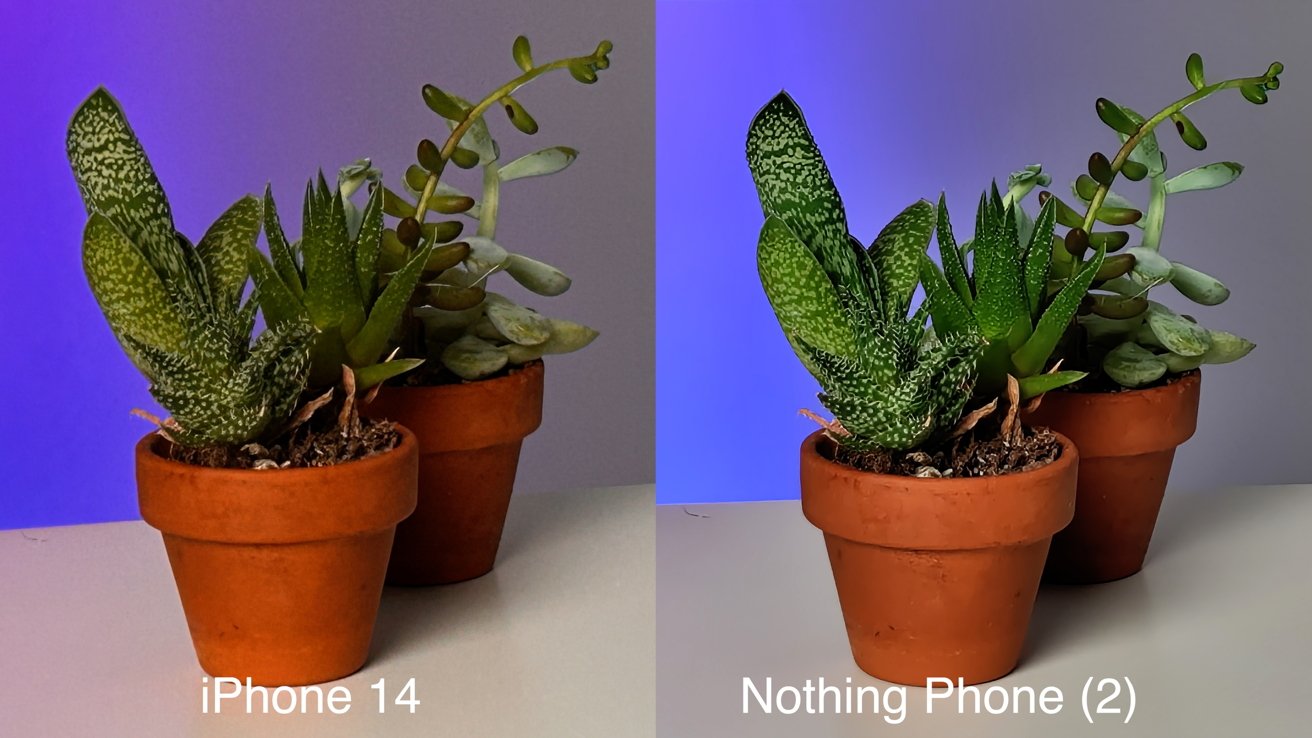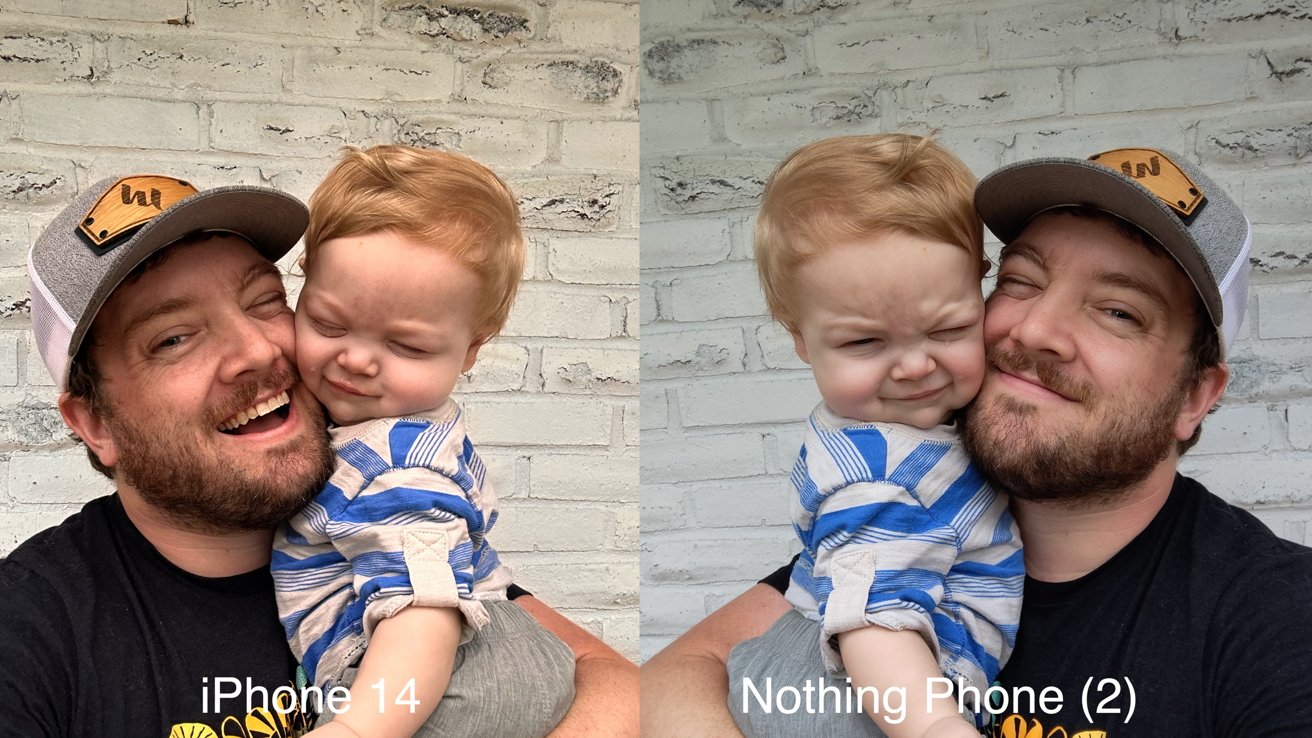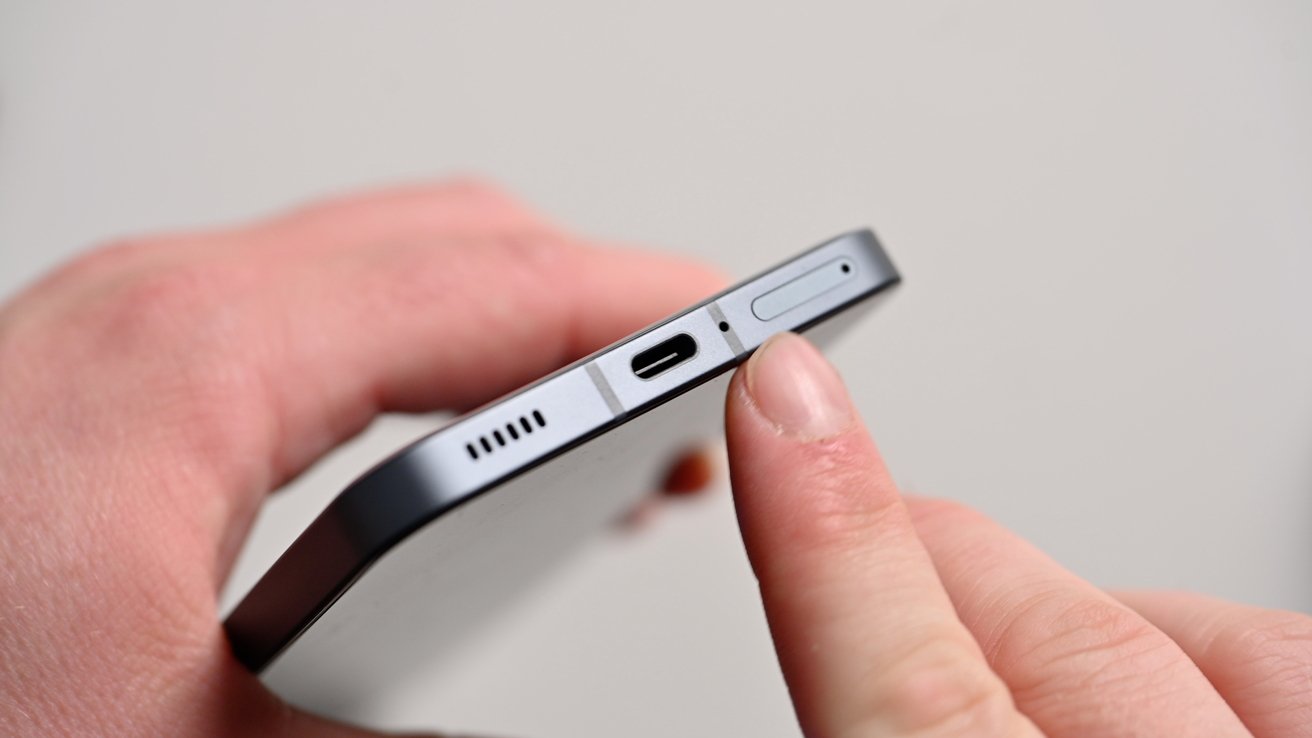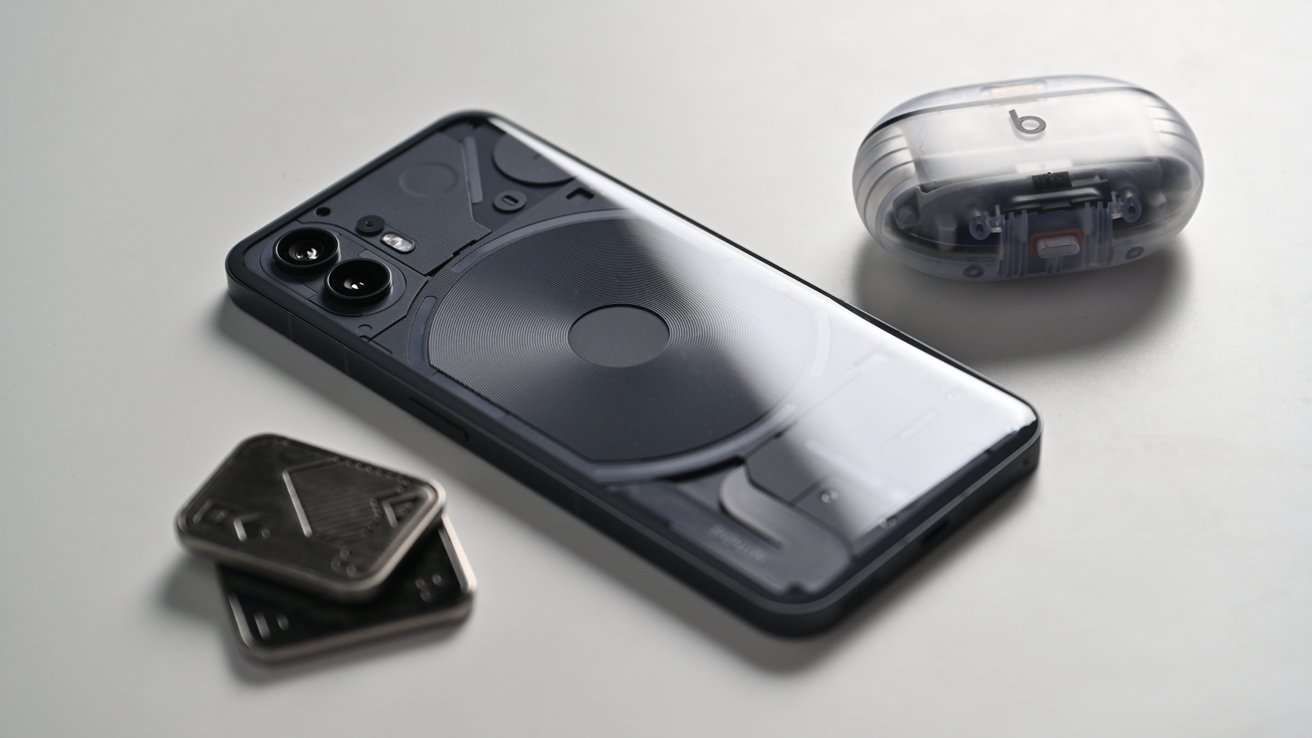Nothing’s second crack at smartphones is a device that tries to take on the iPhone 14 Plus. Here’s how the Nothing Phone (2) compares against the iPhone 14 and its super-sized counterpart.
The Nothing Phone (2) is a continuation of a very well-received initial release. The company has gone for a bigger display, a newer chip, and better photographic chops while leaning into its unique rear lighting system for the second version.
With Nothing aiming for performance and specifications, while still remaining an affordable smartphone, this puts the Nothing Phone (2) in the realm of the iPhone 14. More specifically, the screen brings it more in competition with the iPhone 14 Plus.
iPhone 14 and iPhone 14 Plus vs Nothing Phone (2) – Specifications
| Specifications | iPhone 14 | iPhone 14 Plus | Nothing Phone (2) |
|---|---|---|---|
| Price (starting) | $799 | $899 | $599 |
| Dimensions (inches) | 5.78 x 2.82 x 0.31 | 6.33 x 3.07 x 0.31 | 6.38 x 3.01 x 0.34 |
| Weight (ounces) | 6.07 | 7.16 | 7.09 |
| Processor | A15 Bionic 5-core GPU |
A15 Bionic 5-core GPU |
Qualcomm Snapdragon 8+ Gen 1 Adreno 730 GPU |
| Storage | 128GB, 256GB, 512GB | 128GB, 256GB, 512GB | 128GB, 256GB, 512GB |
| Display type | 6.1-inch Super Retina XDR | 6.7-inch Super Retina XDR | 6.7-inch flexible LTPO AMOLED display |
| Resolution | 2,532 x 1,170 at 460ppi | 2,778 x 1,284 at 458ppi | 2,412 x 1,080 at 394ppi |
| True Tone | Yes | Yes | No |
| ProMotion | No | No | 1-120Hz adaptive refresh rate |
| Biometrics | Face ID | Face ID | Fingerprint Recognition, Face Recognition |
| Wireless Connectivity | 5G (Sub-6GHz and mmWave) Gigabit-class LTE Wi-Fi 6 Bluetooth 5.3 Ultra Wideband Emergency SOS via Satellite |
5G (Sub-6GHz and mmWave) Gigabit-class LTE Wi-Fi 6 Bluetooth 5.3 Ultra Wideband Emergency SOS via Satellite |
5G (Sub-6GHz and mmWave) Gigabit LTE with 4×4 MIMO Wi-Fi 6 Bluetooth 5.3 |
| Physical Connectivity | Lightning | Lightning | USB-C |
| Rear Cameras | 12MP Ultra Wide 12MP Wide |
12MP Ultra Wide 12MP Wide |
50MP Ultra Wide 50MP Wide |
| Video | 4K 60fps, 4K 60fps HDR with Dolby Vision, 1080p 240fps Slo-Mo Sensor-shift optical image stabilization Action Mode |
4K 60fps, 4K 60fps HDR with Dolby Vision, 1080p 240fps Slo-Mo Sensor-shift optical image stabilization Action Mode |
4K 60fps, 4K 30fps HDR, 480fps Slo-Mo OIS and EIS stabilization Action Mode |
| Front Camera | 12MP TrueDepth Autofocus |
12MP TrueDepth Autofocus |
32MP |
| Battery Size | Up to 20 hours of video playback | Up to 26 hours of video playback | 4,700mAh |
| Colors | Midnight, Starlight, Blue, Purple, Yellow, (Product)Red | Midnight, Starlight, Blue, Purple. Yellow, (Product)Red | Black or White |
iPhone 14 and iPhone 14 Plus vs Nothing Phone (2) – Physical Construction
The two families of smartphone have a generally similar construction, consisting of layers of glass sandwiching an aluminum frame. Of course, the aesthetics are very different beyond this point.
The big difference is Nothing’s decision to use clear glass on the back to show elements of the device’s internals. This also exposes the Glyph interface, a series of lights that can provide information to the user without necessarily looking at the display.
In terms of size, Nothing’s device is nearer the iPhone 14 Plus than the iPhone 14.
The Nothing Phone (2) is 6.38 inches long, 3.01 inches wide, and 0.34 inches thick. This is longer than the 5.78-inch iPhone 14 and 6.33-inch Plus, and while Nothing’s wider than the 2.82-inch iPhone 14, it’s a little narrower than the 3.07-inch Plus model.
The thickness of the Nothing smartphone is also more than both iPhones, which each comes in at 0.31 inches.
On weight, the 7.09-ounce Nothing Phone (2) is a little lower than the Plus at 7.16 ounces and up from the 6.07-ounce non-Plus iPhone.
iPhone 14 and iPhone 14 Plus vs Nothing Phone (2) – Display
Apple’s displays are Super Retina XDR screens — OLED panels that measure 6.1 inches and 6.7 inches for the non-Plus and Plus models, respectively. They also have varying resolutions at 2,532 by 1,170 and 2,278 by 1,284, depending on the size.
Nothing’s offering is also 6.7 inches, matching the Plus, but it uses a flexible LTPO AMOLED display. At 2,412 by 1,080, Nothing’s display has a much lower pixel density than Apple’s, at 394 pixels per inch versus 458ppi for the Plus and 460ppi for the standard size.
All screens are capable of HDR and high contrast ratios of 2 million to 1 for Apple, 1 million to Nothing.
Where Nothing comes ahead is in brightness and refresh rate. For brightness, it can handle 1,000 nits of fullscreen brightness and 1,600 nits of peak HDR pixel brightness.
The iPhones can manage 800 nits of typical brightness, 1,200 for peak HDR brightness. In effect, Nothing’s display is closer to the iPhone 14 Pro‘s versions.
Refresh rates are the same story, as Apple maxes out the iPhone 14 and Plus at 60Hz. Nothing provides an adaptive refresh rate of 1Hz to 120Hz, effectively equalling the iPhone 14 Pro models.
iPhone 14 and iPhone 14 Plus vs Nothing Phone (2) – Performance
The iPhone 14 and iPhone 14 Plus both use the A15 Bionic Chip, which uses a six-core GPU with two performance cores and four efficiency cores. That’s accompanied by a 5-core Apple-designed GPU and a 16-core Neural Engine for tasks that benefit from machine learning.
Nothing’s Phone (2) uses a Qualcomm Snapdragon 8+ Gen 1 chipset, which uses a 4-nanometer TSMC production process. It uses one X2 Prime 3.0GHz core, three A710 2.5GHz cores, and four A510 1.8GHz cores, providing a combination of performance and efficiency.
An Adreno 730 GPU handles its graphics.
All of this is used to run Android 13, complete with Nothing OS 2.0, which brings the company’s design language to the operating system.
Apple includes 6GB of memory in its iPhone 14 models, but Nothing varies its own offering. The lowest storage capacity includes 8GB of memory, while the mid and upper levels of storage use 12GB.
For the purposes of benchmarking, we will have to compare iPhone against the OnePlus 10T, which has the same chipset and GPU as the Nothing Phone (2).
According to Geekbench, the OnePlus 10T manages 1,391 for single-core performance, and 3,811 for multi-core. By comparison, the iPhone 14 and iPhone 14 Plus can get to 2,225 for the single-core test, 5,365 for multi-core.
iPhone 14 and iPhone 14 Plus vs Nothing Phone (2) – Cameras
On the back, both smartphone families have wide and ultra-wide cameras available.
Apple’s pair are 12-megapixel versions with a 2x optical zoom out and a 5x digital zoom, and benefit from Apple’s computational photography know-how. This results in a lengthy list of features, including the Photonic Engine, Deep Fusion, Smart HDR 4, Portrait Mode and Portrait Lighting, Night Mode, Panorama, and Photographic Styles.
There’s also automatic image stabilization, with the main wide camera benefiting from a sensor-shift optical image stabilization system.
Nothing’s improved camera setup starts with similar 50MP cameras as last time. However, Nothing now uses an 18-bit image signal processor that can capture 4,000 times more data than the first phone.
As a result, the features list reads a lot like Apple’s, including OIS and EIS image stabilization, HDR, Night Mode, Portrait Mode, Motion Photo, Super-res Zoom, AI scene detection, Panorama, and an Expert Mode.
In our sample tests, the iPhone 14 provided a more saturated image with slightly unrealistic colors.
When we tried the digital zoom capabilities, the iPhone showed its weaknesses. With a 12MP sensor, the 5X digital zoom looked grainy and artificially sharpened, even in a well-lit environment.
The Nothing Phone looked incredibly sharp as if was using optical zoom instead of cropping the primary sensor.
On video, Apple includes the ability to record 4K 60fps footage in HDR with Dolby Vision, a 1080p 240fps Slo-Mo, an Action Mode, Cinematic Mode, and a bunch of other fairly typical features.
Nothing can manage a 4K 60Hz capture, with live HDR at 4K30fps, 1080p at 60fps, 480fps Slo-Mo, a 1080p 30fps Night Mode, and an Action Mode.
Around the front, Apple’s trusty TrueDepth camera array offers 12MP stills 4K 60fps video, 120fps 1080p slo-mo, HDR 4K 60Hz video, and depth mapping, as used for Face ID security.
Nothing upgraded its front camera to a 32-megapixel sensor, which has a Portrait Mode and Night Mode, along with HDR 1080p 30Hz and 1080p 60hz for normal recording.
iPhone 14 and iPhone 14 Plus vs Nothing Phone (2) – Battery
Usually, a comparison of battery life would involve manufacturer-claimed timings and methodologies. Nothing instead provides specifications of its battery, which can give some idea of battery life, but it’s not conclusive.
A battery may be bigger in one phone than another, but depending on how the phone uses the battery, it may not necessarily provide more usable battery life.
Nothing claims it uses a 4,700mAh battery, supporting 15W Qi wireless charging and 45W wired charging.
The iPhone 14 has a 3,279mAh battery, while the Plus has a 4,325mAh version. In both cases, Apple claims up to 20 hours of video playback on the standard model and 26 hours on the iPhone 14 Plus, though we don’t know how that translates to Nothing’s version.
One party trick Nothing offers is 5W reverse charging, namely using the wireless charging system to provide power to another nearby device. This is not a feature Apple’s iPhones currently support.
iPhone 14 and iPhone 14 Plus vs Nothing Phone (2) – Connectivity
For wireless connectivity, the two device families are pretty even. There’s 5G support for both mmWave and sub-6GHz bands, as well as Gigabit LTE with 4×4 MIMO.
Wi-Fi 6 is the same across the board, as is Bluetooth 5.3 support and NFC for payments. Where there’s a difference is that Apple includes Ultra Wideband support in its hardware, whereas Nothing does not.
For physical connectivity, you have Lightning on the iPhones and USB-C on the Nothing. Wireless charging is available, albeit with MagSafe attaching the charger for the iPhones while Nothing doesn’t have that capacity.
Nothing does include a SIM card slot, which isn’t a major feature to consider usually. Apple has switched to dual eSIM only for its iPhone 14 in the United States, but the SIM card slot is still available in other regions of the world.
iPhone 14 and iPhone 14 Plus vs Nothing Phone (2) – Other Features
Security on the iPhones revolves around Face ID, which employs depth mapping using the TrueDepth camera.
Nothing opts for two different systems, with fingerprint recognition being the primary one. There is a face unlock feature, one which is still said to work with face coverings, but this doesn’t use depth mapping at all.
Apple offers an IP68 rating for splash, water, and dust resistance. Nothing manages IP54, which is handy as there’s some resistance, but not to the same level as the iPhones.
Nothing’s big selling point is its rear Glyph system, namely a collection of lights on the rear that can be used to indicate to the user various things without them needing to turn on the device. For some of the lights, there’s a granularity where they can light up in smaller segments.
Each glyph can be used in different ways, such as a countdown timer, battery level indicator, indicate when calls are coming in, or alerting when specific contacts are calling you.
iPhone 14 and iPhone 14 Plus vs Nothing Phone (2) – Capacity and Pricing
The iPhone 14 starts from $799 with a 128GB of storage capacity, with $899 offering 256GB, and $1,099 providing 512GB.
The iPhone 14 Plus follows the same structure but costs another $100. It’s 128GB for $899, 256GB for $999, and 512GB for $1,199.
Nothing starts with the 128GB capacity at $599. Going to 256GB is $699, while 512GB can be achieved for $799.
iPhone 14 and iPhone 14 Plus vs Nothing Phone (2) – What to Buy
Nothing’s second attempt at a smartphone is an improvement on the first and could be considered a statement piece in the Android device world. It has good enough specifications and other qualities to keep owners of the smartphone happy.
The aesthetic and the glyph system are its real selling points, and it will certainly attract people who find the idea of rear-mounted LEDs as a notification system quite a good idea.
While it has improved, it’s fair to say it’s not quite at an iPhone level yet. Indeed, it has the design chops, but it loses at specifications.
Benchmarks point to the iPhones being more powerful, and while it does have its own take on ProMotion that the iPhone 14 doesn’t have, it’s let down by a lower-resolution display.
That said, Nothing’s device is a full $200 cheaper than the iPhone at the lowest capacity option, $300 lower than the iPhone 14 Plus that it’s roughly the same size as. At the upper end of the price scale, that saving increases to $300 and $400, respectively.
The Nothing Phone (2) is good for an Android device and has a great design aesthetic. It’s just not enough to dethrone the iPhone.
Where to buy
The Nothing Phone 2 is available to order at Amazon, where it is currently on sale for $719 at the time of publication.
Apple’s iPhone 14 and 14 Plus are on special at wireless carriers, with Verizon and AT&T offering aggressive iPhone deals on both models.
This story originally appeared on Appleinsider

